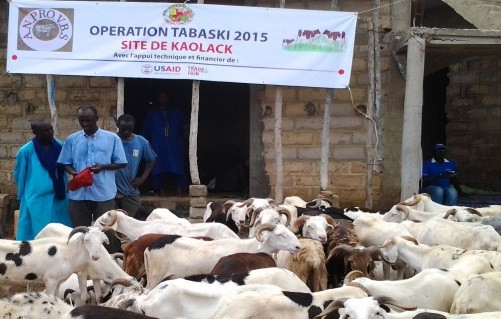Speeches Shim

March 2016—During the Muslim festival of Eid-el-Adha (Feast of Sacrifice), known as Tabaski in West Africa, most households sacrifice a ram or bull. Livestock markets are bustling, and over a million animals are transported and sold across the region in the weeks leading up to this important Islamic holiday.
These livestock markets traditionally are concentrated at only a few sites in major cities, so buyers and sellers often travel long distances at considerable expense. Theft is common, especially after dark, and animals are sometimes injured or killed during transit.
The creation of new livestock markets in secondary cities promises to cut down on travel time and expense for both buyers and sellers. But entering a new market is risky for livestock traders, especially during the short window before Tabaski.
To mitigate these risks, West Africa’s regional livestock association, which works with national federations across the region, partnered with USAID’s West Africa Trade and Investment Hub (link is external). Together, they took specific steps to help traders establish and safeguard sales in new markets.
Two months before the Sept. 24 Tabaski holiday in 2015, the Trade Hub organized trips for the Malian livestock federation to potential market sites in Senegal and Côte d’Ivoire. In each location, Malian livestock sellers and the Trade Hub’s livestock specialist, Dr. Seydou Sidibe, met with municipal officials and federation members in Senegal and Côte d’Ivoire who are familiar with the livestock market supply and demand to discuss how many animals each location required.
They also made plans for holding pens, water, police surveillance, lighting for better security at night and, with Trade Hub guidance, the organization of sales tracking and reporting.
The planning and preparations for these new markets paid off. Results from Operation Tabaski 2015 show that Malian federation members sold more than $36 million worth of sheep and more than $7.5 million worth of cattle in Côte d’Ivoire and Senegal leading up to the Tabaski festival.
Among the traders testing out a new market was Aliou Toure, who in previous years had trucked his sheep from Mali to Abidjan, where he normally waited about 10 days to sell them all. This year, he went to Bouaké in northern Côte d’Ivoire instead—saving time and ultimately making more money.
“My first shipment of 240 sheep was sold the day after my arrival,” Toure said. “I returned to Bouaké three days later with an additional 200 sheep, which I sold in three days. I sold all my sheep at a slightly lower price than in Abidjan in previous years, but given the number of sheep I sold in two trips, I made more money.”
Another Malian trader, Seydani Dicko, also found success in a new market. “This year I decided to try the new site in Foundiougne [Senegal], and I wasn’t disappointed. I sold 1,800 sheep at less cost compared to last year. Many sellers prefer to go to large markets but I realized that, for the same category of sheep, the prices were similar and here the animals are safer.”
USAID’s West Africa Trade and Investment Hub was established in March 2014 to boost trade with and within West Africa. By the end of 2015, the Trade Hub’s activities already helped West African farmers and firms to achieve over $60.4 million in new sales.
LINKS
Follow @USAIDWestAfrica (link is external), on Facebook (link is external)

Comment
Make a general inquiry or suggest an improvement.